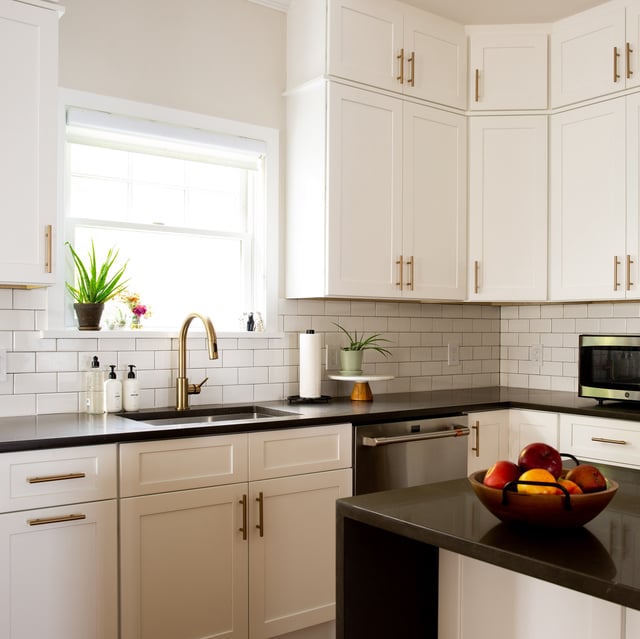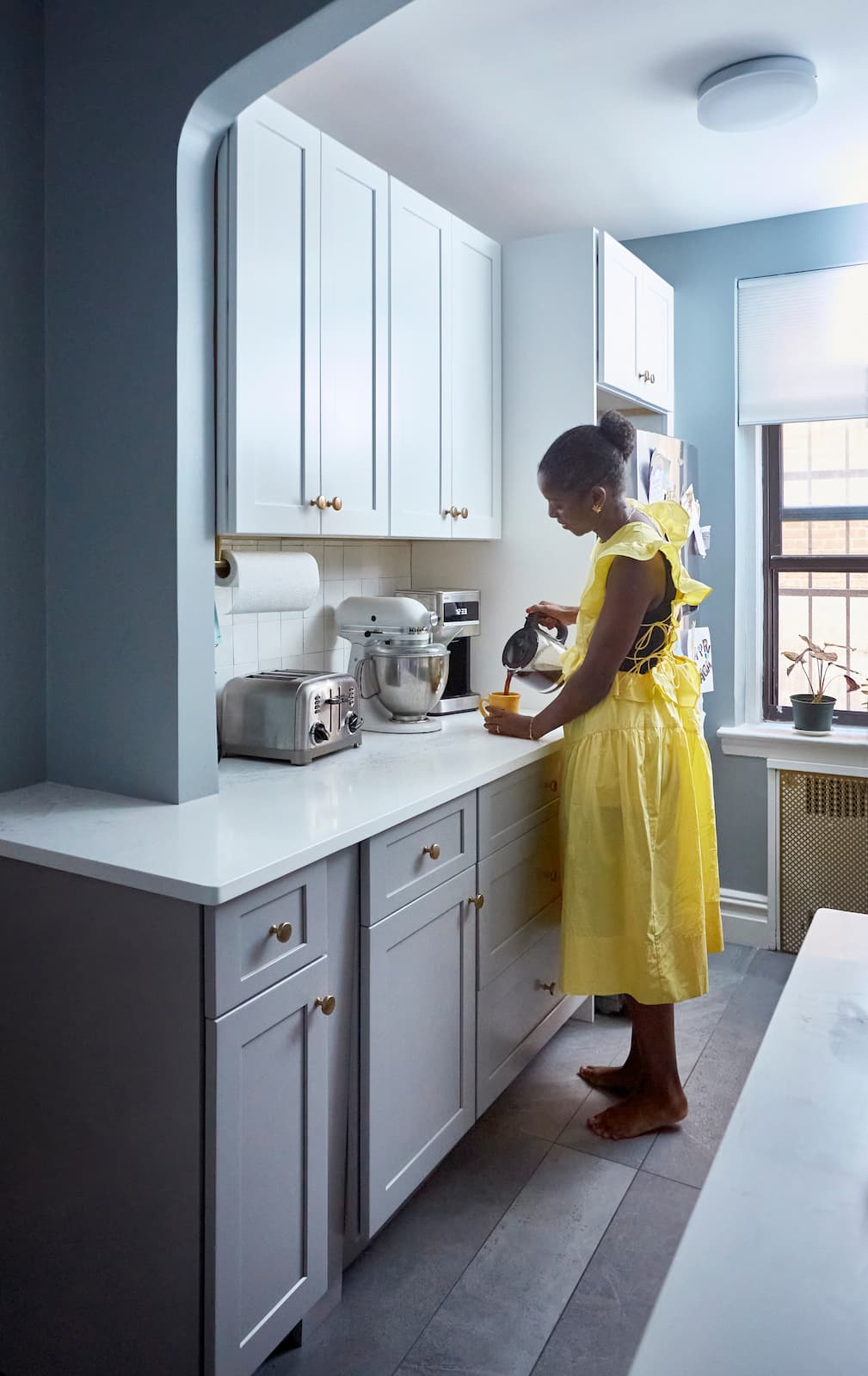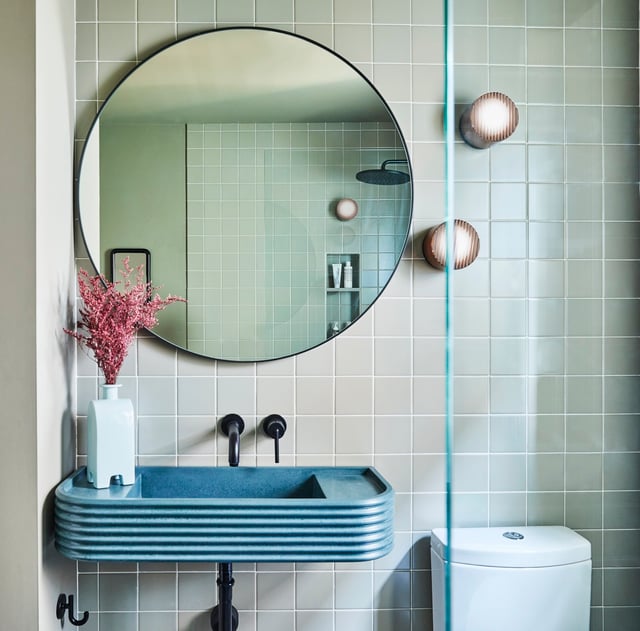
Kitchen
How Long Does a Kitchen Remodel Take?
04.01.2025

In This Article
Tiles might seem like small potatoes when you’re planning a kitchen remodel, but trust me—they’re the secret sauce that makes or breaks the whole recipe. Ever watched helplessly as your backsplash turned into a Jackson Pollock painting thanks to flying pasta sauce? Or tiptoed across a cold, cracked floor tile at 6 a.m., praying the coffee maker starts working miracles? Yeah, choosing the right kitchen tiles isn’t just decorative—it’s practically life-changing.
Design a Home That’s Uniquely Yours
Block can help you achieve your renovation goals and bring your dream remodel to life with price assurance and expert support.
Get Started
Great kitchen tile does three things beautifully: it boosts durability (hello, dropped pans!), elevates aesthetics (who doesn’t love a gorgeous herringbone backsplash?), and improves functionality (easy-clean surfaces = fewer meltdowns during messy baking sessions). The right tiles can handle everything from a toddler tornado to your experimental cooking phases, all while making your kitchen the kind of place you actually want to spend time in.
In this guide, we're diving into the nitty-gritty of kitchen tile selection—covering everything from materials like ceramic versus porcelain to figuring out the perfect tile size and pattern for your space. We’ll share expert tips on balancing style and practicality, sprinkle in some cost-saving advice, and even dish on current tile trends so your kitchen doesn’t scream “last remodeled in 1985.” Whether you're a seasoned DIY-er or just a homeowner praying your contractor knows what they’re doing, this guide is here to help you tile your way to kitchen happiness. Ready to get grouting? Let’s do this.
If you're planning a kitchen remodel, you're probably knee-deep in decisions about cabinets, appliances, and countertops. But let's pause for a second to talk about the unsung heroes of kitchen design: the tiles. Sure, picking tiles might not seem as exciting as choosing that flashy new fridge or ultra-modern oven, but trust me—tiles are the MVPs you never knew you needed.
Let’s face it: your kitchen is a battlefield. Pots boiling over, coffee splattering, kids dropping ketchup-covered nuggets—it's a scene out of a culinary disaster movie. Good tiles can handle all this chaos with superhero-level strength. Quality kitchen tiles resist moisture, which means no moldy grout lines after your latest sink flood. They can handle heat too, so you won't have to panic when that hot pan accidentally lands on the countertop tile. And when it comes to stains, tiles laugh in the face of marinara sauce. Simply put, tiles are the armor that protects your kitchen from everyday disasters.
Beyond toughness, kitchen tiles are your best bet to add some serious style. Want to channel a chic French café vibe? Subway tiles got you covered. Going for that warm, farmhouse feel? Rustic stone tiles will do the trick. Tiles set the tone for your kitchen's personality, whether that's sleek and modern, cozy and traditional, or somewhere comfortably in-between. Think of them as the stylish shoes of your kitchen remodel—pulling the whole look together while making a statement.
Here's the best part: kitchen tiles aren't just pretty and durable—they're also ridiculously easy to clean. Unlike wood or laminate that might warp, stain, or scream "high maintenance," tiles typically just need a quick wipe-down to shine. A spill? Grab a sponge. Muddy paw prints? Mop it and move on. With tiles, you spend less time stressing about cleanup and more time enjoying your beautiful kitchen. And isn’t that exactly what a remodel should be about?
Choosing kitchen tiles sounds easy enough until you find yourself standing in aisle five at the home improvement store, staring at approximately 5,000 tile options. Suddenly, the difference between ceramic and porcelain feels like advanced rocket science. But fear not, brave remodeler—let’s break down exactly what you need to consider picking tiles you'll love (and won't regret in six months).
First things first: your kitchen tiles have to survive everything your family can throw at them—literally. From the hot pan dropped in panic mode to the rogue meatball that escapes spaghetti night, durability is crucial. Ceramic and porcelain tiles are crowd favorites because they’re tough enough to withstand the daily grind of kitchen chaos. Porcelain is especially resilient, practically daring spills and stains to try their worst. Natural stone like marble or travertine? Stunning but requires a bit more TLC. If your house resembles a circus on most days, you’ll appreciate tile that won't surrender to water, heat, or food stains at the first sign of trouble.
Next, size definitely matters when choosing your kitchen tiles. Larger tiles can make your kitchen look sleek, spacious, and modern. Fewer grout lines? Less cleaning—hallelujah! But smaller tiles, like those charming subway or mosaic options, can create texture and visual interest, especially in backsplashes or smaller spaces.
Layout matters too. Want to give the illusion of height? Go vertical. Need more width? Horizontal is your friend. And if you're feeling adventurous, try a herringbone or chevron layout—just know that your tile installer might secretly judge your complexity choices.
Let’s talk aesthetics, shall we? Tiles aren’t just practical; they're also your kitchen’s fashion statement. Neutral colors—think white, gray, or beige—are timeless and versatile, effortlessly complementing any kitchen style. But if you crave excitement, go bold with colorful tiles or striking patterns. Moroccan-inspired tiles or funky geometric patterns can turn your kitchen into the favorite room of the house. Finishes matter too—glossy tiles reflect light beautifully but can be slippery underfoot, while matte tiles offer grip and understated elegance. The choice is yours; just don’t get hypnotized by too many shiny options at once.
Ah, yes—budget. Tiles can range from "Wow, that's surprisingly affordable" to "I might have to sell an organ for this." Thankfully, there’s a wide range of options to suit every wallet size. Ceramic tiles tend to be budget-friendly, while natural stone or designer tiles can quickly eat into your renovation funds. It helps to set a clear budget beforehand (and stick to it), leaving a little wiggle room for unexpected expenses or that irresistible feature tile you spot last minute. Remember, investing in quality tiles usually pays off long-term, reducing the need for frequent replacements or repairs.
Finally, let's get practical. Some tiles are easy DIY jobs—peel-and-stick tiles practically install themselves—but most tile projects benefit from professional installation. Complex layouts, delicate materials, or large-format tiles might require an experienced hand, so factor installation costs into your overall budget.
Maintenance-wise, consider your cleaning habits honestly. If your idea of a deep clean is waving a Clorox wipe around, choose tiles with minimal grout lines and easy-to-clean surfaces like glazed porcelain or ceramic. Natural stone tiles, while gorgeous, typically require regular sealing to maintain their beauty. Pick tiles that fit your lifestyle—not ones that will haunt your dreams every time spaghetti sauce lands on the floor.
In short, choosing kitchen tiles doesn’t have to be overwhelming. Keep these key factors in mind, trust your instincts, and soon enough, you'll be sipping coffee in your stylish, functional, and tile-happy kitchen.
When you’re remodeling your kitchen, picking the right tiles can feel a bit like dating: tons of options, each with different personalities and quirks, and the nagging fear you'll pick the wrong one. Luckily, unlike dating, tiles are pretty straightforward once you know what you're looking for. Let’s dive into the five best types of kitchen tiles that’ll make your remodel a happily-ever-after situation (or at least close enough).
If you're new to tile shopping, ceramic tiles are the perfect starting point. They're popular for a reason—budget-friendly, versatile, and available in countless colors and styles. Here's what you should know before choosing ceramic tiles for your kitchen remodel:
Features and benefits
Ceramic tiles are basically the "comfort food" of kitchen tiles: affordable, reliable, and easy to love. They're made from clay that's fired at high temperatures, making them pretty sturdy and great for everyday use. Plus, ceramic tiles come in virtually every color, pattern, and shape you can imagine, so finding something you like is practically guaranteed.
Best use cases in the kitchen
Ceramic is ideal for kitchen backsplashes, walls, and even flooring in low-to-medium traffic areas. They're especially handy if your kitchen is more homey than high-end, or if your design changes as often as your favorite Netflix show—you won't break the bank switching them out.
Pros and cons
Like every tile choice, ceramic tiles come with their own set of strengths and limitations. Here's a quick look at what you can expect:

If ceramic tiles are the reliable, everyday staple, porcelain tiles are the upgraded, high-performance option. Known for durability, porcelain handles heavy traffic and kitchen chaos without breaking a sweat. Here’s why porcelain tiles might be your kitchen’s new best friend:
Differences between porcelain and ceramic
Think of porcelain as ceramic's overachieving sibling. Porcelain is made from finer clay and fired at hotter temperatures, making it denser and more resistant to water and damage. This difference makes porcelain a heavyweight champion in kitchen tile choices.
Durability and water resistance
Porcelain tiles handle moisture and heat like absolute champs. They resist water absorption, making them perfect for busy kitchens prone to spills, splashes, or general chaos. If your kitchen regularly looks like a war zone, porcelain's got your back.
Pros and cons
Porcelain offers strength and resilience, but at a higher cost and greater complexity during installation. Consider these points:

If your kitchen needs a bit of sparkle and contemporary flair, glass tiles are a fantastic option. With their reflective quality and modern vibe, these tiles instantly make any kitchen feel brighter and more sophisticated. Let’s take a closer look:
Modern aesthetic appeal
Glass tiles are the cool, trendy friend in your tile group chat—they always look effortlessly stylish. With their sleek, glossy finish, glass tiles bring modern sophistication and a touch of sparkle to your kitchen. They instantly upgrade the look of any space, from urban-chic lofts to contemporary family kitchens.
Light reflection and space-enhancing properties
One secret weapon of glass tiles: they bounce light around your kitchen, making it feel brighter and more spacious. Perfect if your kitchen resembles a cozy closet more than a cooking arena—glass tiles will create the illusion of extra square footage without knocking down walls.
Pros and cons
While visually appealing, glass tiles have some limitations you’ll want to keep in mind before installing them:
If you’re looking for luxury and elegance, natural stone tiles are your go-to. With unique patterns and textures, they deliver unmatched beauty and class—but they require extra care. Here’s what to consider:
Unique patterns and luxury appeal
If your kitchen were attending a gala, natural stone tiles would be dressed in a tuxedo—luxurious, classy, and unique. Every stone tile has its own pattern, offering a look you simply can’t replicate with synthetic materials. Marble screams luxury, granite offers rugged charm, travertine adds warmth, and slate brings earthy vibes.
Maintenance considerations
Like all fancy things, natural stone tiles require a bit more attention. Most need regular sealing to prevent stains, discoloration, or moisture damage. Think of this maintenance as the skincare routine your kitchen deserves—invest time and care, and you'll reap beautiful results.
Pros and cons
Natural stone is a high-end choice, offering elegance but requiring commitment to care:
When in doubt, subway tiles never disappoint. Versatile and timeless, they easily adapt to various kitchen designs and remain perpetually stylish. Here’s why they’re a classic choice:
Classic and timeless look
Subway tiles are the denim jeans of kitchen decor—they never go out of style. Born in the subways of New York City (as the name suggests), these rectangular tiles create clean, classic lines that match nearly any kitchen theme. They're the ultimate safe yet stylish choice.
Versatility in different kitchen styles
Whether your kitchen leans farmhouse rustic, urban industrial, or minimalist modern, subway tiles blend seamlessly. You can stack them straight, offset them in a brick pattern, or jazz things up with herringbone layouts. They're basically foolproof for indecisive remodelers.
Pros and cons
While subway tiles are widely loved, they're not without their drawbacks:

Matching tiles with kitchen style
The first step is matching your tile choice to your kitchen’s overall vibe. Sleek, minimalist spaces love glossy porcelain or glass tiles, while traditional or farmhouse styles favor ceramic or natural stone. Choosing tiles that complement your kitchen’s personality ensures a cohesive, inviting look.
Choosing between matte vs. glossy finishes
Matte tiles provide texture and traction, ideal if you're prone to spills or have kids and pets running wild. Glossy tiles, however, reflect light beautifully, making smaller kitchens feel larger. Consider your lifestyle—are you chasing aesthetics or practicality (or hopefully a bit of both)?
Grout selection and maintenance tips
Grout isn't the most glamorous part of tiling, but choosing wisely can save you cleaning nightmares later. Dark grout hides dirt but can dominate visually, while lighter grout looks clean but shows every pasta-sauce incident. Consider epoxy grout—it costs a bit more but resists staining and simplifies cleanup.
Renovate with confidence every step of the way
Step 1: Personalize Your Renovation Plan
Step 2: Receive Quotes from Trusted Contractors
Step 3: Let Us Handle the Project Details

DIY vs. professional installation
If you're handy and patient, DIY installation can save serious cash—especially with simpler tiles like ceramic or subway tiles. But porcelain, natural stone, or complex layouts might require professionals. Honestly assess your DIY abilities (and your stress tolerance), then choose accordingly.
Common mistakes to avoid
Common errors include ignoring the importance of level surfaces, improper grout sealing, and miscalculating tile quantities (nothing ruins the weekend like a mid-project tile shortage). Double-check measurements, buy extra tiles for mistakes, and prep your surface carefully.
Sealing and maintaining tiles for longevity
Sealing tiles—especially stone—is essential for long-term beauty. Regularly reseal porous tiles like marble, travertine, or granite to prevent stains and damage. Your future self (and kitchen) will thank you.
Price ranges for different tile types
Ceramic tiles typically cost $2 to $8 per square foot, porcelain ranges from $4 to $12, glass tiles hover around $7 to $30, and natural stone can soar from $10 to $50 (or more!). Subway tiles remain affordable, typically under $10 per square foot, making them a budget-friendly option.
Factors that influence costs
The total cost of kitchen tiling includes tile material, installation labor, and grout. Complex designs, branded tiles, and premium materials significantly impact pricing. Remember, installation often costs nearly as much as the tiles themselves, so budget accordingly.
Budgeting tips for a cost-effective remodel
Set your budget first, then stick to it. Mix premium tiles sparingly as accents, not entire surfaces. Avoid complex patterns if you're budget-conscious, and always shop around for deals.
Transparent Pricing You Can Trust

Daily cleaning tips
Regular sweeping and spot cleaning keep tiles looking fresh. For routine cleaning, mild soap and water usually do the trick. A quick daily wipe-down can prevent buildup.
Best products for tile care
For stubborn stains, use products specifically labeled safe for your tile type—avoid acidic cleaners on natural stone. Simple solutions like warm water, vinegar, or mild tile-specific cleansers typically work wonders.
Long-term maintenance strategies
Seal tiles periodically based on material recommendations. Porcelain and ceramic are virtually maintenance-free, whereas stone demands regular sealing. With proper care, kitchen tiles can last decades, turning your remodel into a lasting investment rather than a passing trend.
Picking kitchen tiles might feel daunting at first, but armed with this knowledge, you're ready to choose confidently. Soon, you’ll be cooking up a storm in your newly tiled, envy-worthy kitchen!
Alright, let's recap: kitchen tiles aren’t just pretty—they’re durable, functional, and basically your kitchen’s best friend. Remember, there’s a perfect tile out there for every style, spill-prone family, and budget-conscious remodeler.
So, go forth confidently and pick tiles that truly speak to your kitchen dreams (and realities). Ready to stop dreaming and start tiling? Find a contractor to install your dream kitchen tiles today—and say goodbye to boring floors and backsplashes forever!
What is the most durable type of kitchen tile?
Are porcelain tiles better than ceramic for kitchens?
What is the best tile size for a small kitchen?
How do I clean and maintain my kitchen tiles?
Can I install kitchen tiles myself, or should I hire a professional?

Renovate confidently with Block
Easily compare quotes from top quality contractors, and get peace of mind with warranty & price protections.
Thousands of homeowners have renovated with Block

4.5 Stars (100+)

4.7 Stars (100+)

4.5 Stars (75+)

Kitchen
How Long Does a Kitchen Remodel Take?
04.01.2025

Design
The Ultimate Guide to Kitchen Tiles with Tile Options
04.01.2025

Design
What is a Frameless Glass Shower Screen?
03.25.2025

Design
How to Convert a Bathroom for ADA & Handicap Accessibility
03.13.2025

Design
The Ultimate Guide to Bathroom Sizes
03.13.2025
Renovate confidently